
Understanding Acute Respiratory Distress Syndrome (ARDS)
Acute Respiratory Distress Syndrome (ARDS) is a severe lung condition characterized by fluid-filled lungs, low oxygen levels, and rapid onset of respiratory distress. Learn about its causes, pathophysiology, clinical manifestations, diagnostic evaluation, and medical management in this comprehensive guide.
Download Presentation

Please find below an Image/Link to download the presentation.
The content on the website is provided AS IS for your information and personal use only. It may not be sold, licensed, or shared on other websites without obtaining consent from the author. If you encounter any issues during the download, it is possible that the publisher has removed the file from their server.
You are allowed to download the files provided on this website for personal or commercial use, subject to the condition that they are used lawfully. All files are the property of their respective owners.
The content on the website is provided AS IS for your information and personal use only. It may not be sold, licensed, or shared on other websites without obtaining consent from the author.
E N D
Presentation Transcript
ACUTE RESPIRATORY DISTRESS SYNDROME PRESENTED BY: PRATIBHA CHARAN NURSING TUTOR
INTRODUCTION Acute respiratory distress syndrome(ARDS) is a medical emergency in which the lungs due to direct or indirect injury fill with fluid. This results in low oxygen level. ARDS is known for its rapid onset after the first sign of respiratory distress, usually within 24 to 48 hours of the original disease.
DEFINITION Acute respiratory distress syndrome is a sudden, progressive form of respiratory failure characterized by severe dyspnea, refractory hypoxemia.
CAUSES Aspiration Drug overdose Injury to the chest Near drowning Pneumonia Microorganism ( virus, bacteria, or fungal) Fat embolus Massive smoke inhalation Hypertension Increased intra cranial pressure
PATHOPHYSIOLOGY Due to etiological factors Injury to the alveolar capillary membrane Increased alveolar capillary membrane permeability Outward migration of blood cells and fluid from capillaries Pulmonary edema Impaired gas exchange ARDS
CLINICAL MANIFESTATION Shortness of breath Tachypnea Cough Restlessness Diaphoresis Cyanosis Crackles sound in lungs Hypercapnia Wheezing Confusion Lethary
DIAGNOSTIC EVALUATION History collection Physical examination Chest X- ray CT-Scan MRI ABG analysis Bronchoscopy Sputum culture ECG
MEDICAL MANAGEMENT No specific therapy for ARDS exits. Supportive measure: supplemental oxygen Mechanical ventilation Change position every 4thhour once and maintain turning schedule. MEDICATIONS Antibiotics Anti inflammatory drugs such as corticosteroid Diuretics to reduce pulmonary edema Anti anxiety bronchodilators
